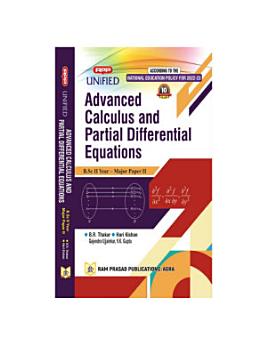ADVANCED CALCULUS & PARTIAL DIFFERENTIAL EQUATIONS
מידע על הספר הדיגיטלי הזה
1.1 Historical background :
1.1.1 A brief historical background of Calculus and partial differential equations in the context of India and Indian heritage and culture
1.1.2 Abrief biography of Bodhayana
1.2 Field structure and ordered structure of R, Intervals, Bounded and Unbounded sets, Supremum and Infimum, Completeness in R, Absolute value of a real number.
1.3 Sequence of real numbers
1.4 Limit of a sequence
1.5 Bounded and Monotonic sequences
1.6 Cauchy’s general principle of convergence
1.7 Algebra of sequence and some important theorems
–Unit-II–
2.1 Series of non-negative terms
2.2 Convergence of positive term series
2.3 Alternating series and Leibnitz’s test
2.4 Absolute and Conditional Convergence of Series of real terms
2.5 Uniform continuity
2.6 Chain rule of differentiability
2.7 Mean value theorems and their geometrical interpretations
–Unit-III–
3.1 Limit and Continuity of functions of two variables
3.2 Change of variables
3.3 Euler’s theorem on homogeneous functions
3.4 Taylor’s theorem for function of two variables
3.5 Jacobians
3.6 Maxima and Minima of functions of two variables
3.7 Lagrange’s multiplier method
3.8 Beta and Gamma Functions
–Unit-IV–
4.1 Partial differential equations of the first order
4.2 Lagrange’s solution
4.3 Some special types of equations which can be solved easily by methods other than the general method
4.4 Charpit’s general method
4.5 Partial differential equations of second and higher orders
–Unit-V–
5.1 Classification of partial differential equations of second order
5.2 Homogeneous and non-homogeneous partial differential equations of constant coefficients
5.3 Partial differential equations reducible to equations with constant coefficients





